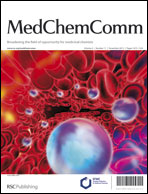Exploring the selectivity of PI3Kα and mTOR inhibitors by 3D-QSAR, molecular dynamics simulations and MM/GBSA binding free energy decomposition†
Abstract
PI3Kα (phosphatidylinositol-3-kinase α) and mTOR (the mammalian target of rapamycin) have been treated as anticancer targets in recent years. Since isoform-specific inhibitors may be tolerated at doses that result in complete inhibition without generating side effects, a selectivity study is valuable. In this paper, 3D-QSAR CoMFA models on 72 selective inhibitors were established using the conformations docked to the homology models, which show satisfactory linear correlations (PI3Kα: r2 = 0.839, rpred2 = 0.743; mTOR: r2 = 0.813, rpred2 = 0.932). The results reveal that the electrostatic field in the hinge region, the steric field and electrostatic field in the solvent accessible region and the affinity subpocket have critical impacts on selectivity. To validate the 3D-QSAR models and further explore the origin of the selectivity at the amino acid residue level, molecular dynamics simulations followed by MM/GBSA binding free energy decomposition were conducted, and the result shows that R770, S773, Q859 of PI3Kα and E2190, C2243 of mTOR are the significant residues, which is in accordance with the 3D-contour maps of CoMFA. By combination of comparative analysis of binding sites, building of 3D-QSAR models and MM/GBSA binding free energy decomposition, those residues which can introduce ligand selectivity were discovered and further validated.


 Please wait while we load your content...
Please wait while we load your content...